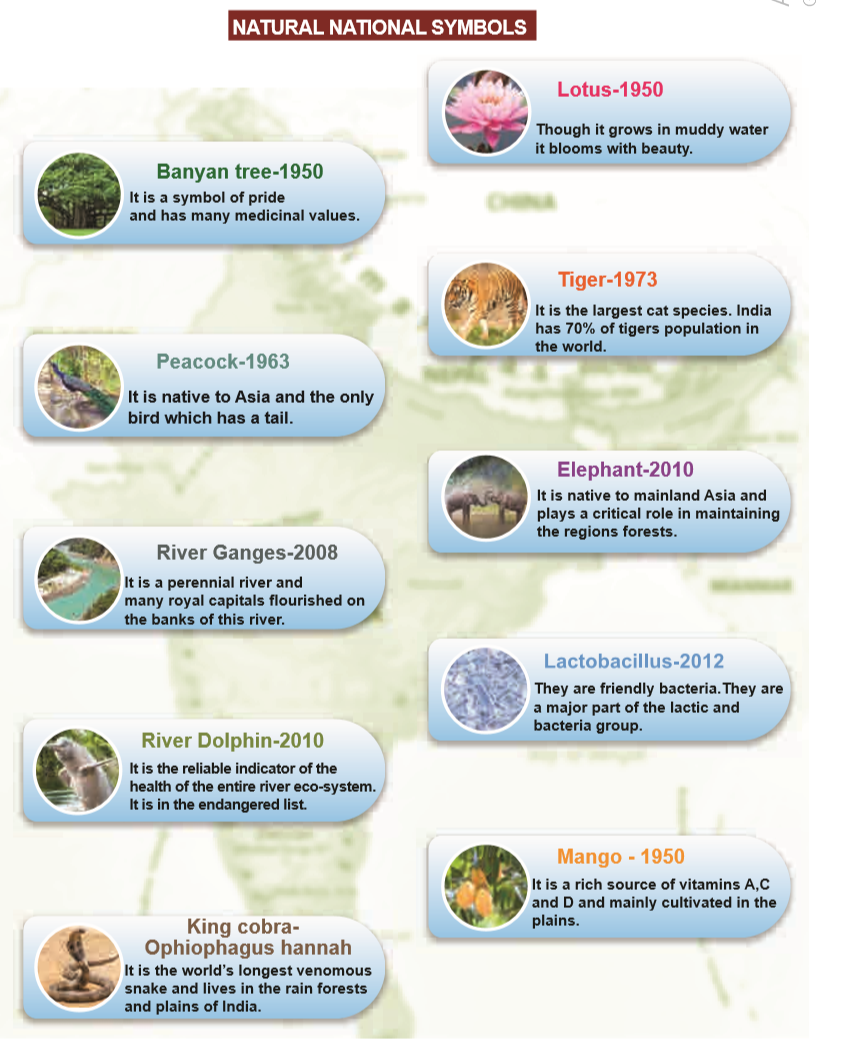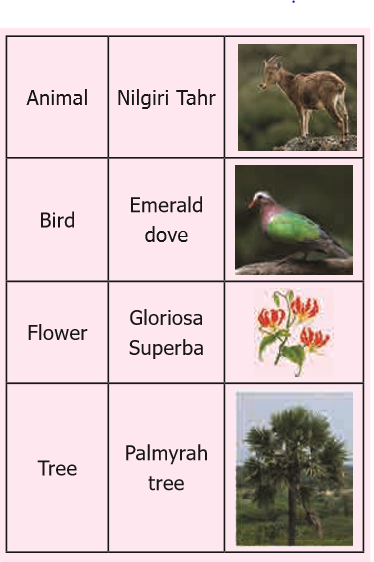National Symbols Notes 6th Social Science
National Symbols Notes 6th Social Science
6th Social Science Lesson 13 Notes in English
13. National Symbols
1. “Lotuses are of different types. Those which are pink are called pink lotuses. The lotus has a very special structure”.
2. Peacock dances only during rainy days. But once a chieftain Began, wondered whether the peacock was shivering in cold and covered the peacock with his shawl. This chieftain belonged to the classical Sangam age of Tamils and also revered as one of the seven most generous personalities of ancient Tamil land.
3. There is a Peacock Sanctuary at Viralimalai in the district of Pudukottai (Tamilnadu)
4. Why Peacock is made us our National Bird?
For a long time the Peacock has a significant place in our culture, art and heritage. It’s beauty, stately appearance and its even distribution all over India makes it our national bird.
5. Explain the Features of River Dolphin?
There are river dolphins in our country. The dolphins that live in the rivers have a long snout similar to the Gharial crocodiles. Just like bats, they use the ultrasound waves to catch their prey. They are essentially blind.
6. Which is the longest river in India?
The river Ganga is 2,525 km long and is the longest river in India Though Brahmaputra is 3848 km long, it does not flow across India.
6th Social Book Back Questions
7. Which was the Mango cultivated during the Mughal Period?
The kind of mango is known as ‘Imam pasand’ a variety of mango that was cultivated during the Mughal reign for the royal family. This is occasionally found in the forest. Even this was picked from the mango grove at the fringes of this forest.
8. Famous Banyan Trees in India:
The famous banyan tree in the Indian Botanical Garden in Howrah (Calcutta). There is another big banyan in Adyar (Chennai).
9. Give a detail about snake:
The only reptile that builds a nest of its own and reproduces. Thus snake’s average length is 18 feet and is the longest of the poisonous snakes.
10. National Symbols and their adopted years:

11. Various Symbols of Tamil Nadu:

Recently Cirrochroa thais also known as Tamil yeoman is declared as the state butterfly of Tamil Nadu.
12. Describe the colour feature of National Flag:
- The tricolour flag is our National flag.
- The three colours are of the same width and are arranged horizontally. The saffron at the top represents valour and sacrifi ce.
- The green at the bottom represents fertility and prosperity.
- The white band in between represents honesty peace and purity.
- The Ashoka chakra or the wheel in navy blue represents truth and peace.
13. Describe the size of the National Flag:
Out National Flag’s length and width proportion is 3:2 respectively and the Ashoka’s chakra has 24 spokes in it.
14. What was our National Emblem?
The four lions on top of the Ashoka Pillar at Sarnath was chosen to be our National emblem.
15. When was our National Emblem accepted?
The national emblem was accepted on 26th January 1950, ‘Satyameva Jayate” has been inscribed at its bottom. It means ‘Truth alone triumphs’.
16. Describe our National Emblem:
- The National emblem consists of two parts- the upper and the lower parts.
- The upper part has four lions facing the North, South, East and West. This is on a circular pedestal. One can only see three lions at a time.
- The lower part has an elephant, a horse, a bull and a lion. The ‘Wheel of righteousness’ is placed between them. This emblem is found at the top of the government communication, Indian currency and passport.
17. Explain about National Anthem:
‘Jana Gana Mana’ is our National anthem. It symbolises the sovereignty and intergrity of our nation. This anthem was written by Rabindranath Tagore in Bengali. This was transcripted in Hindi and was accepted by the Constituent Assembly on 24th January 1950.
18. The rules to be observed while singing the Anthem:
- The anthem has to be sung at a duration of 52 seconds.
- Everyone should stand erect while singing the national anthem.
- One should understand the meaning while singing.
19. Who composed the National Song?
The song Vande Mataram, composed by Bankim Chandra Chatterjee, was a source of inspiration to the people of India in their struggle for freedom. It has an equal status with Jana Gana Mana.
20. Explain the Importance given for National Song?
On January 24, 1950, the then President, Dr. Rajendra Prasad came up with a statement in the Constituent Assembly, “the song Vande Mataram, which has played a historic part in the struggle for Indian freedom, shall be honoured equally with Jana Gana Mana and shall have equal status with it.” The song was a part of Bankim Chandra’s most famous novel ‘Anand Math’.
21. Explain National Pledge:
National pledge “India is my country. All Indians are my brothers and sisters” is our national pledge. The pledge was written by Pydimarri Venkata Subba Rao in Telugu.
22. Which Micro organism is called as National Micro Organism?
The curd which we consume every day is curdled from milk by a micro organism called lacto bacillus delbrueckii. This was accepted as our national micro organism in the year 2012.
23. Currency of India (INR):
The Indian currency is the Indian Rupees. The currency released by SherShah Sur in the sixteenth century was ‘Rupiya’. This ‘rupiya’ has been transformed, into ‘Rupees’. The symbol of rupees is ₹. This was designed by D. Udhayakumar from Tamil Nadu in the year 2010.
24. Explain National Calender:
During the reign of Emperor Kanishka he began following a new calendar in the year 78 CE/AD. The year begins from the spring equinox which falls on March 22nd. During a leap year, it begins on March 21st. Our country follows this calendar.
25. Who Recommended this National Calander?
The famous astronomer Meghnad Saha headed the Calendar Reformation Committee on 22nd March 1957. It was then accepted by the committee as our national calendar. The National symbols help in uniting the diversified sections of India and to instill patriotism.
26. Why Independance is Celebrated?
Every year, August 15 is celebrated as the Independence Day to commemorate India’s freedom from British rule. This auspicious day is also marked as a birth of the world’s biggest democracy, India.
27. Explain the Spent Events on that Day:
On the day India gained independence, Mahakavi Bharathiyar’s poem “Aaduvome Pallu Paduvome” and it was sung over the AIR (All India Radio) by T.K.Pattammal, a famous singer of Carnatic Music. The celebration of Independence Day continues every year. The Prime Minister unfurls the National Flag on the Independence Day at the Red Fort, New Delhi.
28. Why Republic Day is celebrated?
On 26th January 1950, India was declared as a democratic state. Every year this day is commemorated as the ‘Republic Day’. The constitution commenced on 26th January 1950. From August 1947 to 26th January 1950, the Queen of Britain was the honorary head of India.
29. Who hoist the Flag on Republic Day?
The day India was declared as a democratic state, the President became the first citizen of India. On Republic Day, the President of India hoists the National flag at the Red Fort New Delhi.
30. When was Gandhi Jeyanthi Celebrated?
The birthday of Mahatma Gandhi, the Father of our Nation, was declared one of the National festivals. It falls on 2nd October.
31. Who declared October 2 as International Day of Non-violence?
In 2007, the United Nations declared October 2nd as the ‘International Day of Non-violence’.
32. On January 29, the third day of the Republic day, the celebrations are brought to an end with the “Beating Reteat” ceremony. This is performed by the bands of Indian Army, Navy and Airforce. The President of India is the chief guest of this day. Rashtrapati Bhavan will be illuminated at 6pm as a part of the celebration.
33. On 27th December 1911 this National anthem was sung for the first time during the Congress committee meet held at Kolkata.
34. The four lions, chosen from the Sarnath pillar of Ashoka as our emblem, is now placed in the Sarnath Museum.
35. Importance of National Flag:
- The National flag was designed by Pingali Venkayya from Andhra Pradesh.
- The first Indian Flag was woven at Gudiyatham in Vellore district of Tamilnadu.
- This flag was hoisted by Pandit Jawaharlal Nehru on 15th August 1947 at Red Fort (Delhi)
- This flag is now an exhibit at the St.George’s Fort Museum, Chennai.
36. Why Thirupur Kumaran was called as Kodi Kaatha Kumaran Tirupur?
- Kumaran was born in Chennimalai of Erode district. As a youth, he actively participated in the freedom struggle for India.
- In 1932, when Gandhiji was arrested, protests were held against the arrest all over the country.
- When protests were held for Gandhiji’s release, Tirupur Kumaran took active part in it. He lost his life when the police attacked violently.
- He held on to the tricolor flag even when he died.
37. How Kumaran was Honoured?
He was honoured with the title, ‘Kodi Kaatha Kumaran’. The Government of India has released a postal stamp on his centenary year to remember Tirupur Kumaran’s sacrifice and dedication to the nation.